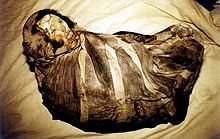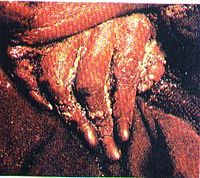- Mummy Juanita
-
Momia Juanita (Spanish for "Mummy Juanita"), also known as the Inca Ice Maiden and Lady of Ampato, is the well-preserved frozen body of an Incan girl who was killed as an offering to the Inca gods sometime between 1450 and 1480, at approximately 11–15 years old. She was discovered on Mount Ampato (part of the Andes cordillera) in southern Peru in 1995 by anthropologist Johan Reinhard and his Peruvian climbing partner, Miguel Zárate. "Juanita" has been on display in Catholic University's Museum of Andean Sanctuaries (Museo Santuarios Andinos) in Arequipa, Peru almost continuously since 1996, and was displayed on a tour of Japan in 1999.
The body caused a sensation in the scientific world due to its well-preserved condition. In 1995, Time magazine chose it as one of the world's top ten discoveries. Between May and June 1996, it was exhibited in the headquarters of National Geographic Society in Washington D.C., in a specially acclimatized conservation display unit (engineered by the Carrier Corporation), which donated two of these units to Catholic University. In its June 1996, issue, National Geographic included an article dedicated to the discovery of Juanita.[1]
Contents
Discovery
In September 1995, during an ascent of Mt. Ampato (20,700 ft), Reinhard and Zárate found a bundle inside the crater that had fallen from an Inca site on the summit. To their astonishment, the bundle turned out to contain the frozen body of a young girl. They also found many items that had been left as offerings to the Inca gods strewn about the mountain slope down which the body had fallen. These included statues and food items. A couple of days later, the body and the items were transported to Arequipa, where the body was initially kept in a special refrigerator at Catholic University.
Two more ice mummies, a young girl and a boy, were discovered in an archaeological expedition led by Dr. Reinhard the following year. Owing to melting caused by volcanic ash from the nearby erupting volcano of Sabancaya, most of the Inca burial site had collapsed down into a gully that led into the crater. Reinhard published a detailed account of the discovery in his 2006 book entitled, The Ice Maiden: Inca Mummies, Mountain Gods, and Sacred Sites in the Andes.
Scientific analyses
Body
As Reinhard and Zárate struggled to lift the heavy bundle containing Juanita's body on Ampato's summit, they realized that her body mass had probably been increased by freezing of the flesh. When initially weighed in Arequipa, the bundle containing "Juanita" weighed over 90 pounds. Their realization turned out to be correct; Juanita is almost entirely frozen, making her a substantial scientific find. Unlike other high-altitude Inca mummies, Juanita was frozen by ice and thus her remains and garments were not desiccated like that of mummies found in other parts of the world; technically she is thus not a mummy, though the term is often used to describe her. Her skin, organs, tissues, blood, hair, stomach contents and garments are extremely well-preserved, offering scientists a rare glimpse into Inca culture during the reign of the Sapa Inca Pachacuti.
Analysis of her stomach contents revealed that she ate a meal of vegetables 6–8 hours before her death.[2]
Health
CT scans and biopsies of the body in addition to dental analysis suggest that Juanita was in good health, had excellent nutrition, and there was no evidence of disease.
Clothing and adornments
Juanita was wrapped in a brightly-colored burial tapestry (or "aksu"). Her head was adorned with a cap made from the feathers of a red macaw, and she wore a colorful woolen alpaca shawl fastened with a silver clasp. She was fully clothed in garments resembling the finest textiles from the Inca capital city of Cuzco. This, in addition to evidence of excellent health, suggests that she may have come from a noble Cuzco family. These were almost perfectly preserved, providing valuable insight into sacred Inca textiles and how the Inca nobility dressed.
Tools and equipment
Found with her in the burial tapestry was a collection of grave goods: bowls, pins, and figurines made of gold, silver, and shell.
Genetic analysis
According to the Institute for Genomic Research (TIGR), her closest kin are the Ngobe people of Panama, but she also shared genetic patterns found in people from Taiwan and Korea. Scientists at TIGR examined two mitochondrial DNA D loop sequences and found that Hypervariable region 1 (HV1) was consistent with Haplogroup A, one of the four Native American gene groups. Hypervariable region 2 (HV2) included a unique sequence not found in any of the current mitochondrial DNA databases.[3] Her haplotype is 16111T, 16223T, 16290T, 16319A[4]
Cause of death
Mummy Juanita was a human sacrifice in the Inca capa cocha. Radiologist Elliot Fishman concluded that she was killed by blunt trauma to the head.[5] He observed that her cracked right eye socket and the two-inch fracture in her skull are injuries "typical of someone who has been hit by a baseball bat.” The blow caused a massive hemorrhage, filling her skull with blood and pushing her brain to one side.[6]
See also
- Plomo Mummy
- Chinchorro mummies
- Ötzi the Iceman
- Pazyryk Ice Maiden
References
- ^ Reinhard, Johan: Peru’s Ice Maidens. National Geographic 189(6) (June): 62-81, 1996
- ^ "Ice Maiden Virtual Autopsy". Andes Expedition - Searching For Inca Secrets. National Geographic. 1997. http://www.nationalgeographic.com/features/97/andes/. Retrieved 19 May 2011.
- ^ "DNA: The Key to the Mystery". Andes Expedition - Searching For Inca Secrets. National Geographic. 1997. http://www.nationalgeographic.com/features/97/andes/autopsy/lower3.html. Retrieved 19 May 2011.
- ^ http://www.isogg.org/ancientdna.htm International Society of Genetic Geaneology - Ancient DNA
- ^ "Ice Mummies: Frozen in Heaven" (Television series transcript). NOVA. PBS. PBS Airdate: November 24, 1998. http://www.pbs.org/wgbh/nova/transcripts/2516frozen.html. Retrieved 19 May 2011.
- ^ "Fatal Head Injury: Cracked Eye Socket and Skull Fracture". Andes Expedition - Searching For Inca Secrets. National Geographic. 1997. http://www.nationalgeographic.com/features/97/andes/autopsy/lower6.html. Retrieved 19 May 2011.
- Inca Mummies, Mountain Gods, and Sacred Sites in the Andes. 2005, Washington, D.C.: National Geographic Society
- Reinhard, Johan: Sharp Eyes of Science Probe the Mummies of Peru. National Geographic 191 (1) (January): 36-43, 1997.
- Reinhard, Johan: Discovering the Inca Ice Maiden. National Geographic Society, Washington, D.C., 1998.
- Reinhard, Johan: New Inca Mummies. National Geographic 194 (1) (July): 128-135, 1998.
External links
Categories:- Mummies
- Human remains (archaeological)
- Archaeological artefacts
- Archaeology of Peru
Wikimedia Foundation. 2010.


